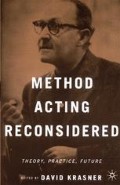Abstract
In this chapter I want to complicate the picture of Method acting that has accompanied attacks on psychological realism since the mid-1980s. With the help of Bakhtinian concepts, I propose a reexamination of the Methods foundations in Stanislavsky as well as Sanford Meisner’s American derivative. I argue that although Method acting can serve to perpetuate the status quo, it also holds the potential to produce change: of emotion, as transformed by memory and by the circumstances of performance; of verbal and nonverbal behaviors, as they are assimilated from others and transformed by reiteration; and finally, of actors and the given dramatic circumstances, as they engage in mutual transformation.
Access this chapter
Tax calculation will be finalised at checkout
Purchases are for personal use only
Preview
Unable to display preview. Download preview PDF.
Notes
Timothy J. Wiles, The Theater Event: Modern Theories of Performance (Chicago: University of Chicago Press, 1980)
Philip Auslander, “Just Be Yourself: Logocentrism and Difference in Performance Theory,” in Acting (Re)considered: Theories and Practice, Phillip Zarrilli, ed. (London: Routledge, 1995), 60.
On the production of the books and the role of Elizabeth Hapgood, see Benedetti, SB, 289–90, 297–300. On the translation issue, see Sharon Carnicke, “An Actor Prepares/Rabota aktera nadsoboi, Chast’I: A Comparison of the English with the Russian Stanislavsky,” Theatre Journal 36.4 (1984): 481–94.
M. M. Bakhtin, “Response to a Question from the Novy Mir Editorial Staff,” Speech Genres and Other Late Essays, Vern W. McGee, tr. (Austin: University of Texas Press, 1986), 7.
M. M. Bakhtin, “Author and Hero in Aesthetic Activity,” Art and Answerability, Vadim Liapunov, tr. (Austin: University of Texas Press, 1990), 23
Caryl Emerson, The First Hundred Years of Mikhail Bakhtin (Princeton, NJ: Princeton University Press, 1997)
A thorough argument for the proposition that thought is inner speech is outside the scope of my discussion here. See, for example, Lev Semenovic Vigotsky, Thought and Language, Eugenia Hanfmann and Gertrude Vakar, eds. and trs. (Cambridge, MA: MIT Press, 1962).
Editor information
Copyright information
© 2000 David Krasner
About this chapter
Cite this chapter
Carlson, M. (2000). Acting and Answerability. In: Krasner, D. (eds) Method Acting Reconsidered. Palgrave Macmillan, New York. https://doi.org/10.1007/978-1-349-62271-9_4
Download citation
DOI: https://doi.org/10.1007/978-1-349-62271-9_4
Publisher Name: Palgrave Macmillan, New York
Print ISBN: 978-0-312-22309-0
Online ISBN: 978-1-349-62271-9
eBook Packages: Palgrave Literature & Performing Arts CollectionLiterature, Cultural and Media Studies (R0)

